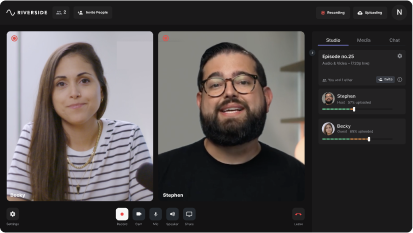Last Updated
May 5, 2023
Why Do Podcasters Wear Headphones? | 11 Reasons - Riverside

Have you ever wondered why your favorite podcasters never seem to part with their headphones?
It’s not just a fashion statement (though it sometimes can be) – there are plenty of valid reasons behind it!
In this article, we’ll look at 9 reasons why podcasters and their headphones are inseparable.
Do you need headphones while podcasting?
Yes, having you (or your guests) wear headphones during a podcast can greatly improve the audio quality of your podcast.
Here’s how:
If a guest speaks too loudly (or softly), the listener will have to strain themselves to hear what’s they’re saying. And if there’s too much ambient noise, the quality of the podcast can suffer even more.
But by wearing headphones, you can monitor all these things and make changes (in real-time) – making sure your podcast sounds crystal clear and smooth.
Additionally, it’ll also help you block out distractions from the outside and stay focused on the podcast.
11 Reasons Why Podcasters Wear Headphones:
There are various reasons why podcasters always have a headphone on them. Here are 9 of them:
1. To hear themselves speaking
How you hear yourself vs. how the microphone (and the audience) hears you are two entirely different things.
If you’ve ever recorded yourself and played the audio back, you probably know what I mean (and yes, I know, it usually ain’t pretty).
The reason for this jarring difference is because of the way sound is conducted in each of these situations.
When we hear ourselves, what we perceive is the result of sound traveling through the air + the sound traveling through our skull and tissues. Because of this, our sound appears deeper and fuller, but it’s only because bone and tissue have enhanced lower-frequency vibrations.
When we hear ourselves through a recording, the sound we hear is the result of sound traveling through the air. That’s why podcasters must know how they sound on a podcast. They get a glimpse of how the audience perceives them, which lets them modulate their voices accordingly.
2. Monitoring their voice
Some beginner podcasters may think they’re talking at a reasonable pace. But in reality, they usually talk pretty fast. They may also think you’re enunciating words clearly. But in actuality, they might be mumbling or slurring a lot of words. This usually happens because they don't have a feedback mechanism to tell them how they sound.
Headphones are that feedback mechanism letting you know how you sound and allowing you to modulate your speech in real-time
By being aware of how you sound to your audience, you can alter their tone, pitch, and pronunciation to convey your message more effectively.
3. Monitoring other sounds
Podcasters use headphones to keep tabs on both their own voice levels and those of their guests, as well as to ensure that audio elements such as music and sound effects are well-balanced and clear.
4. To block out external sound
When recording a podcast, various background noises can interfere with the recording, like–
- Outside disturbances like traffic, sirens, and dogs barking
- Buzzing from electronic appliances or devices
- Hard drive or fan noise from a computer
- Clothes rustling
- And more
Wearing headphones, especially those that excel at blocking out noise, can help create a more intimate environment for podcast discussions.
5. To prevent echoes
Ever been on a virtual call with someone who refuses to use headphones? And then experienced the discomfort of hearing your voice echoed from their speakers?
This can be bothersome.
But that’s why podcasters use headphones instead of speakers. This prevents echoing and helps make the podcast sound better.
6. To prevent clipping and distortion
High audio levels can result in distorted or clipped sound, making listening unpleasant.
However, podcasters can mitigate this by wearing headphones and monitoring audio levels. If the sound spikes too high, they can adjust the input gain on their recording equipment. They can also speak at a lower volume if needed.
7. Consistency in audio levels
A podcast’s audio levels might fluctuate widely during its recording. For instance, a guest might inadvertently move away from his microphone, causing the volume to dip. Also he might tire out during a long podcast and speak more softly over the course of it.
So it’s important to monitor audio levels in real-time and make adjustments. This could involve encouraging guests to speak up or asking them to move closer to the microphone. It could also involve fine-tuning their own volume to match that of their guests.
8. To hear guests better
Headphones produce better audio output than speakers. They help the podcaster better hear and understand what a guest is saying – without having to interrupt and ask them to repeat themselves.
This makes conversations more engaging and natural, without interferences and misunderstandings.
9. To add sound effects in a balanced manner
While adding sound effects to the podcast, its volume must be harmonized and balanced with the speakers’ voices and other audio elements. This is another reason to wear headphones – it lets the podcaster be cognizant of adding these effects in a non-jarring manner.
10. For editing and post-production
During post-production, podcasters use headphones to detect distortion, background noise, and imbalances in audio.
Audio generally sounds different with speakers versus using headphones. If you know your audience will likely listen with headphones, then it’s best to use them when editing. This ensures you’ll hear your audio exactly how your audience will listen to it, and you can make adjustments accordingly.
11. The ‘Podcaster Look’
Some may say podcasters who sport headphones look ‘cooler’ than those who don't. That's why some of them wear headphones – it might be a bit superficial, but hey, it's totally valid! I
What headphones do podcasters use?
Here are some popular headphones used by podcasters:
Under $100

- Audio Technica ATH-m20x: The ATH-M20Xs are great entry-level headphones. Their lightweight plastic build makes them comfortable for extended use.
- Sennheiser 280 PRO: These closed-backed headphones are ideal for podcasts as they block out mid-range sound (like ambient chatter) and have good leakage performance.
Between $100 - $200

- Sony MDR7506: Known for its sound quality, comfort, and durability, the Sony MDR7506 has accurate and well-balanced audio reproduction. This lets podcasters effectively monitor their recordings and make precise edits to their audio content.
- Sennheiser HD-25: The HD-25s are considered an industry standard for DJs and perform excellently in loud environments.
- Audio-Technica ATH-M50x Professional Studio Monitor Headphones: These are among the most popular over-ear headphones in the market. They’re very comfortable and can be used both in a studio setting as well as outside it.
$200 and over

- Shure SRH940: The Shure SRH940 is a professional studio-grade headphone with accurate sound reproduction and an ergonomic design for comfort.
- Bose QuietComfort 35 wireless headphones II: The QC35IIs, one of Bose's most popular releases, feature excellent Acoustic Noise Cancelling technology, effectively blocking background noise to enable more focused conversations.
$400 and above

- Shure SRH1540: These have a sturdy, stylish build with excellent sound quality. With a frequency range of 5Hz - 25Hz, they give detailed audio reproduction, which can help you monitor audio better.
- Sennheiser HD 660S: The lightweight design of the HD 660S makes them comfortable to wear for long periods. Additionally, their open-back design does a fantastic job of preventing sound leakage.
Best Headphones with Built-in Mic

- Audio-Technica BPHS1: The Audio-Technica BPHS1 is great if you don’t want to spend on a separate mic for recording podcasts. Its gooseneck boom mic can be switched to the left or right side, depending on what feels better for you.
- Sennheiser HMD 300 Pro-XQ-2: This one comes with a super-cardioid mic that’s perfect for recording in noisy environments.
You can get more details about these above headphones by checking out our in-depth article on podcast headphones.
Tips on how to set up headphones for podcast
Here are some tips for setting up your headphones – the right way – before starting a podcast:
- Make sure your headphones are comfortable: Recording a podcast can take time, and you’ll have to wear headphones for a while. So wear them comfortably so you don’t have to keep adjusting them mid-stream.
- Don’t keep the volume too high: Keep the volume at a reasonable level. Cranking the volume too high for long periods of time can damage your hearing over time.
- Test your audio: Before starting the podcast, use your headphones to check if your voice is distortion-free. Adjust your audio interface's input gain and EQ settings if necessary.
- Keep your headphones on during recording: While recording, continue monitoring audio levels as well as making sure that of the guests’ is proper.
- Label your headphone settings: Are you using a mixer or audio interface with multiple headphone outputs? Then label each output and the corresponding volume settings for each participant. This will help you quickly identify and adjust individual levels during the recording.
FAQs on Why Do Podcasters Wear Headphones
Why do people on podcasts use headphones?
People on podcasts use headphones primarily to monitor audio levels and sound quality in real-time. It helps them identify and correct any issues during recording.
Additionally, wearing headphones helps minimize audio feedback and echo.
Do podcasters hear their own voice with their headphones on?
Yes, one of the reasons that podcasters use headphones is to hear their own voice. This allows them to modulate and balance the sound of their voice with that of their guests.
It also lets them gauge how their audience might hear them, so they can tailor and adjust their voice for greater impact.















-(1)-(1).png)
.png)
.png)
 (1).webp)
.webp)
.webp)








